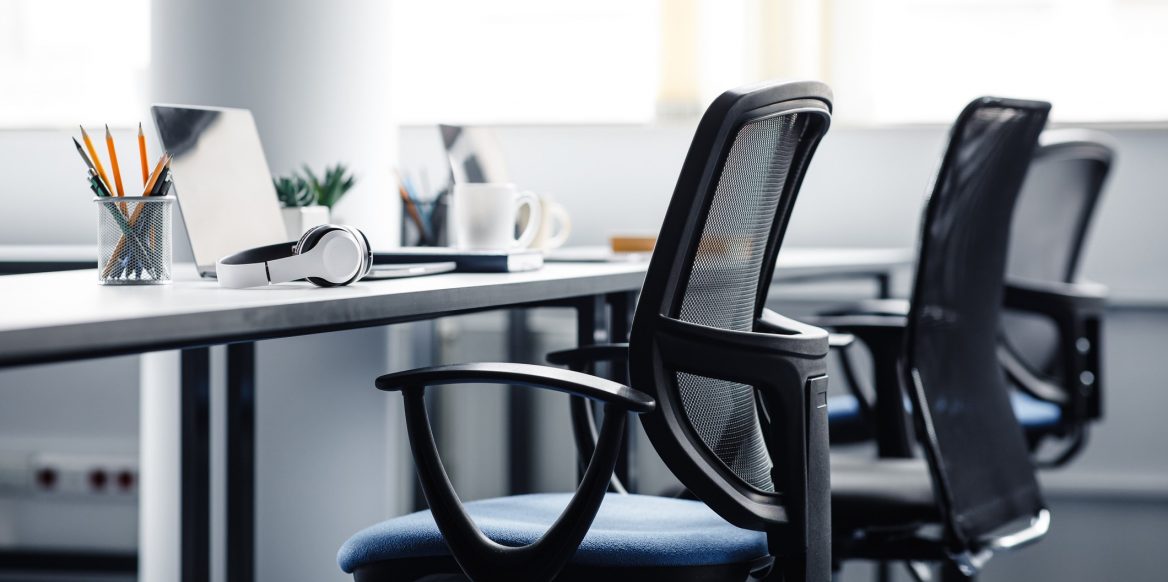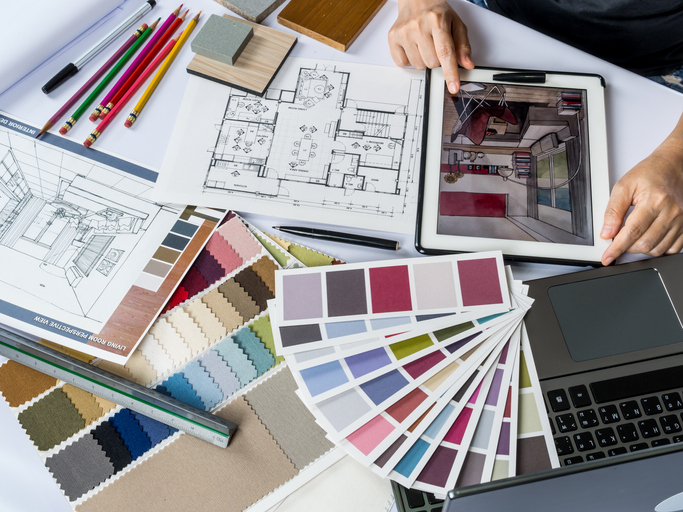As more people return to work, the modern office space should be tailored to their changing needs. For example, nearly 50% of employees place socialization as a top priority. With this and other modern considerations in mind, here are 10 ways you can optimize your office space for the people who spend their working hours under your roof.
Download Printable Article (PDF) >>>

1. Incorporate Comfortable Seating
Some employees may spend hours sitting at a desk. Americans sit for an average of 13 hours a day. So, it’s essential to have comfortable and supportive furniture in the modern office space. Consider investing in ergonomic desk chairs. These usually have an adjustable height and depth and lumbar support. This allows workers to sit with their feet on the floor and improves posture. Also, look for chairs with armrests.
To provide more comfort, add standing desks. These will allow employees to have their monitors at eye level. Keep in mind comfortable seating can increase employee productivity, making your tenants happier.
2. Have Flexible Spaces
You want a combination of open and private spaces. Employees working remotely may primarily use the office space for group meetings, so it’s important to have areas that foster collaboration. These should have a more
open layout and proper lighting. Other workers will want a quiet area to get work done. With more people spending time at home, their house may be a bit chaotic. The office can be a place for employees to escape family distractions. You also want to have private rooms, then. For these spaces, consider using sound-absorbent material, such as acoustic foam.
Along with workspaces, some employees will want areas to socialize. Include break rooms or game rooms as part of the design layout. You may even want to have space where employees can go to relax, such as a
rooftop garden. Bringing in plants can make workers feel calm. In fact, greenery can reduce stress levels and boost mood. They can even improve concentration and productivity by 15%.
 3. Have Easy Access to Technology Sources
3. Have Easy Access to Technology Sources
Make sure desks are placed near outlets so employees can plug in their computers. Also, think about the best spots for printers, Wi-Fi routers, and projectors. Talk with the IT department to determine the best way
to lay out the space. You also want to provide reliable connections for conference calls. Consider adding electrical power outlets to the tables. This way, employees can charge their devices during the meeting.
It’s also crucial to have a dependable Wi-Fi connection. This will allow the businesses to run more efficiently. Fiber internet is a good option for its higher speeds. It also works well for digital collaboration and video communication.
4.Get Employees Involved
Have the manager ask employees what they want. Let them be involved in making decisions about the furniture and function of spaces. Also, consider letting them have a say in lighting and temperature settings.
Having more control over their work environment can make employees happier. Also, keeping employee preferences in mind can improve your relationship with your tenants.
5. Create Collaborative Areas
In 2020, about 71% of people worked remotely. So, coming into the office is a chance to connect with coworkers. It also allows employees to bounce ideas off each other. To design these areas, set up computers on long tables to encourage people to gather. You can also place a few comfortable chairs in a circle to promote conversation. Another benefit of collaborative workspaces is they can reduce costs.
6. Have Proper Lighting
Lighting can improve employees’ mood and productivity. So, create open spaces with windows that take advantage of natural light. You can also add desk lamps to increase the brightness of cubicles. The lighting
color can also make a difference. Blue light can improve alertness and performance. Along with blue lighting, consider using LED bulbs to enhance energy efficiency. These use 75% less energy than incandescent lighting. This can help the planet and reduce your utility bills. You can also use smart lights for more convenience.
7. Be Aware of the Temperature
It’s important to make sure employees feel comfortable within the office. Having a too-cold or too-warm temperature can impact workflows and lead to complaints. Consider buying a smart thermostat that will learn your tenants’ temperature preferences. They can also be controlled remotely. For the warmer months, you may want to install a window air conditioner or place fans around the workplace. Also, be sure to have an updated HVAC system. Over time the filters can get clogged, impacting your ventilation and air quality. To prevent this, change your air filters every three months.
8. Add Some Office Decor
 While an office is meant to be functional, adding some decorations can brighten up the space. Consider adding plants, artwork, or inspirational quotes. You can even include some company branding elements, such as displaying the logo. Here are some other design ideas to consider:
While an office is meant to be functional, adding some decorations can brighten up the space. Consider adding plants, artwork, or inspirational quotes. You can even include some company branding elements, such as displaying the logo. Here are some other design ideas to consider:
• Area rugs
• Mirrors
• Accent table
• Accent walls
• Bookshelves
However, you don’t want to overdo it. Too much decor can overwhelm employees and visitors. Try to find a balance between professionalism and fun.
9. Increase Technology Usage
The modern office space relies on virtual communication, it’s important to have the technology available. Technology is key in helping businesses with important tasks such as collaborating, connecting with customers, and
training employees. Adding projectors and screens in meeting rooms allows employees to engage effectively.
Also, with fewer people at the office, consider installing a visitor management system. This can enhance security by keeping track of who goes in and out. It also makes the check in process go faster.
Another way to use technology is to install a smart security system. With employers limiting office capacity, this can help keep your property protected.
Also, investing in cybersecurity is important since co-workers and clients share data.
10. Include Office Amenities
The modern office space is becoming more than just a place to work. Since employees complete projects remotely, the workplace can be used to form connections. So, add in some amenities, such as exercise equipment, to keep your tenants happy. Also, this can promote exercise and encourage a healthier lifestyle. You can keep it simple and add a comfy sofa or bean bag chairs.
Here are some of the top amenities employees desire:
• Accessible, welcoming restrooms
• Green spaces
• Foods and beverages
• Customizable chairs
• Library or game room
How to Create a Modern Office Space
As employee priorities change, you need to rethink how offices are designed. It’s important to create flexible spaces that encourage connection. Follow these tips as you go about enhancing your office space to appeal to modern companies, modern workflows, and modern employees.
Rose Morrison is a residential and commercial real estate writer and the managing editor of Renovated. To see more of her work visit: https://renovated.com/



